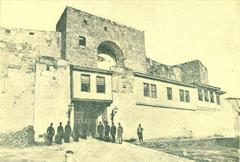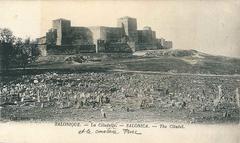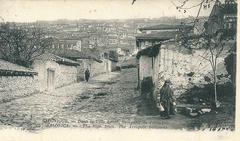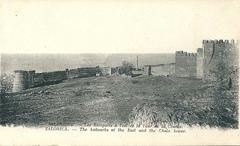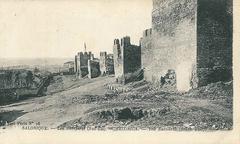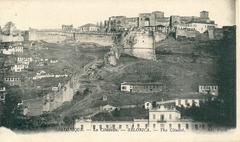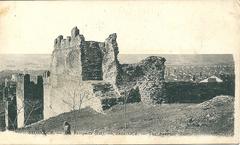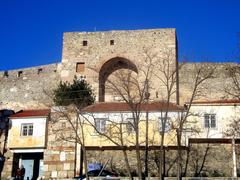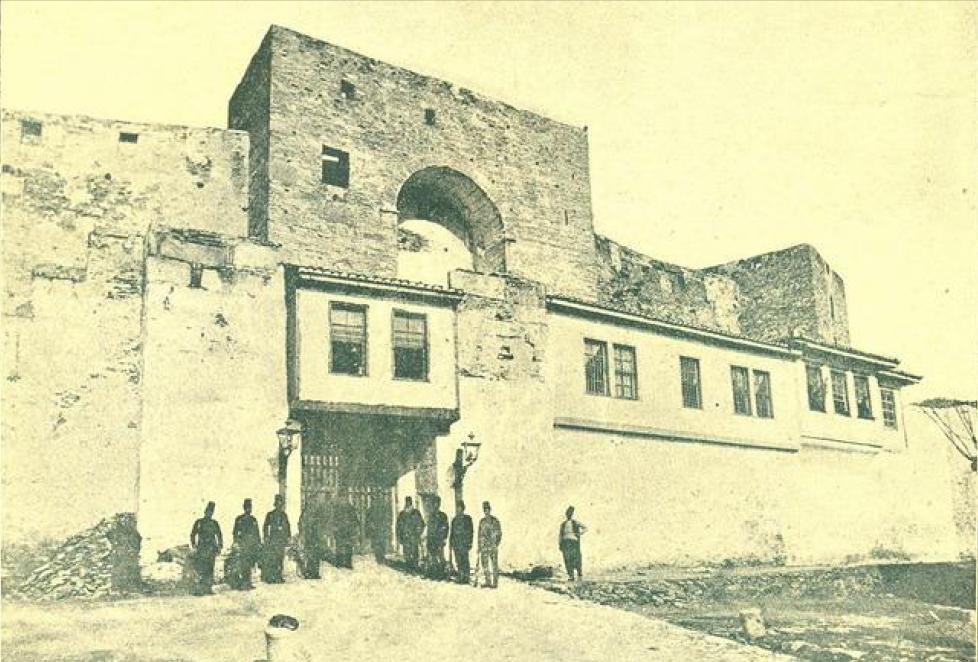
Heptapyrgion Thessaloniki: Visiting Hours, Tickets, and Historical Sites Guide
Date: 14/06/2025
Introduction
Perched atop Thessaloniki’s ancient acropolis in Ano Poli (Upper Town), the Heptapyrgion Fortress—also known as Eptapyrgio or Yedi Kule—stands as a compelling testament to the city’s layered history. Despite its name, which translates as “Fortress of Seven Towers,” the complex features ten towers, reflecting its architectural evolution through the Byzantine and Ottoman periods. Beyond its defensive function, the fortress became infamous as a prison, shaping much of Thessaloniki’s modern memory. Today, the Heptapyrgion offers panoramic views over the city and Thermaic Gulf, making it an essential destination for anyone interested in Thessaloniki historical sites. This guide provides a comprehensive overview of its history, architectural features, visiting hours, ticket details, accessibility, and practical tips to make the most of your visit.
For expanded context on the fortress and Thessaloniki’s heritage, see guides from Thrillophilia, Nikana.gr, and inthessaloniki.com.
Table of Contents
- Historical Overview
- The Heptapyrgion’s Urban and Cultural Context
- Architectural Features
- Restoration and Archaeological Work
- Visiting the Heptapyrgion
- Frequently Asked Questions (FAQ)
- Summary and Final Tips
- References
Historical Overview
Origins and Early Construction
The Heptapyrgion’s origins trace back to late Antiquity and the Byzantine period, with the earliest fortifications believed to have been constructed in the 4th century AD under Emperor Theodosius I. The fortress was strategically positioned at the highest point of Thessaloniki’s acropolis, serving as the city’s principal defensive stronghold (Thrillophilia, Balkazaar). The five northern towers are among the oldest, while the southern towers were added during the 12th and 14th centuries when the Palaiologan dynasty reinforced the structure (Greeka.com).
Architectural Evolution
After the Ottoman conquest in 1430, the fortress was renamed “Yedi Kule” and modified for administrative and residential purposes. The Ottomans added a prominent entrance tower and reinforced the walls, maintaining the site’s military significance (inthessaloniki.com).
Transformation into a Prison
By the late 19th century, the Heptapyrgion was converted into a prison, a function it retained until 1989. It housed both common criminals and political prisoners, playing a notorious role during turbulent periods such as World War II, the Greek Civil War, and the military junta (Balkazaar, inthessaloniki.com). The site’s prison legacy remains a significant part of its identity.
Modern Era and Preservation
Since its closure as a prison, the Heptapyrgion has undergone extensive restoration and preservation under the Greek Ministry of Culture. Archaeological research and collaborative projects with institutions such as Aristotle University have uncovered new insights and helped stabilize the structure, transforming it into a monument open for public exploration (Wikipedia, Nikana.gr).
The Heptapyrgion’s Urban and Cultural Context
Located in Ano Poli, Thessaloniki’s Upper Town, the fortress rises above a neighborhood characterized by narrow streets, traditional houses, and lively local cafés. Its elevated position offers sweeping vistas of the city, the Thermaic Gulf, and, on clear days, Mount Olympus. The Heptapyrgion forms part of a larger defensive system, including the city’s Byzantine walls, and stands as a symbol of Thessaloniki’s resilience and layered cultural memory (Balkazaar, inthessaloniki.com).
Architectural Features
Towers and Defensive Structures
The complex is named for “seven towers,” though it actually features ten, including the prominent Trigonio Tower. The five northern towers date to late Antiquity, and the five southern towers were constructed and reinforced during the Byzantine era (Thessaloniki Tourism, Holidify). The Ottomans added a significant entrance tower in the 15th century.
Walls, Gates, and Interior Layout
The fortress walls rise up to 12 meters and are up to 4 meters thick, showcasing stone masonry and brickwork typical of Byzantine military architecture. The main gate is fortified with double doors and a portcullis, while smaller postern gates allowed controlled access (Greeka.com, Wikipedia). The interior once contained barracks, storerooms, and cisterns, later replaced by prison cells and administrative buildings in the 19th and 20th centuries (Cestee.com).
Construction Materials and Defensive Features
The fortress’s military engineering includes thick stone walls, brick bands, crenellated parapets, arrow slits, machicolations, and underground cisterns. These features highlight the evolution of defensive strategies from the Byzantine to Ottoman eras (Nikana.gr).
Restoration and Archaeological Work
Following its decommissioning as a prison, the Heptapyrgion has been the focus of restoration and archaeological studies. Efforts include photogrammetric surveys, educational collaborations, and the discovery of early Christian sites within the fortress (Wikipedia). Ongoing projects aim to preserve the monument and enhance visitor understanding through exhibitions and interpretive signage.
Visiting the Heptapyrgion
Visiting Hours
- General Hours: The Heptapyrgion is generally open Tuesday to Sunday from 8:30 AM to 3:30 PM. It is closed on Mondays and certain public holidays.
- Exhibitions: Some exhibition areas, such as the prison history displays, may have limited hours (typically 11:00 AM to 2:00 PM).
- Note: Hours may vary seasonally. Always confirm on the official Thessaloniki tourism website or with the Ministry of Culture before your visit (Holidify).
Tickets and Admission
- Entry Fee: Admission is generally free. Some special exhibitions or events may require a ticket, usually available on-site or via official online platforms.
- Discounts: For group visits or educational programs, advance booking is recommended.
Accessibility and Getting There
- Access: The fortress is situated atop a steep hill in Ano Poli. Visitors can reach it by:
- Bus: City bus number 23 stops near the entrance (Cestee.com).
- Walking: A scenic but steep walk from the city center through historic streets.
- Accessibility: The site’s historic terrain includes uneven stone paths and staircases, which can be challenging for those with mobility impairments. Comfortable footwear is essential.
Guided Tours and Visitor Tips
- Guided Tours: Available occasionally through local tourism operators and the Thessaloniki Tourism Organization. Booking in advance is advised for in-depth historical context.
- Visitor Tips:
- Visit early in the day for cooler temperatures and fewer crowds.
- Bring water, sun protection, and a camera.
- Exercise caution on uneven surfaces and supervise children.
Photographic Highlights & Nearby Attractions
- Views: The ramparts provide panoramic vistas over Thessaloniki, the Thermaic Gulf, and Mount Olympus.
- Nearby Sights: Combine your visit with the Byzantine Walls, Trigonion Tower, Vlatadon Monastery, and the Archaeological Museum of Thessaloniki (Greeka.com).
Frequently Asked Questions (FAQ)
Q: What are the Heptapyrgion visiting hours?
A: Tuesday to Sunday, 8:30 AM to 3:30 PM; closed Mondays and public holidays. Exhibition areas may have separate hours.
Q: Is there an entrance fee?
A: General entry is free. Some exhibitions or events may require a ticket.
Q: How do I get to the Heptapyrgion?
A: Take city bus 23 or walk from the city center (be prepared for a steep climb).
Q: Is the site accessible for visitors with mobility issues?
A: Accessibility is limited due to uneven terrain and historic staircases.
Q: Are guided tours available?
A: Yes, but they should be booked in advance through local operators or tourism offices.
Q: What else can I see nearby?
A: Byzantine Walls, Trigonion Tower, Vlatadon Monastery, and other Upper Town attractions.
Summary and Final Tips
The Heptapyrgion Fortress is a landmark of Thessaloniki’s endurance, having served as a military bastion, Ottoman administrative center, and notorious prison. Today, it offers a compelling blend of stunning views, robust architecture, and historical depth. Although accessibility is limited, the fortress is freely open to the public, and a visit can be combined with nearby historic sites for a deeper appreciation of Thessaloniki’s heritage. Take advantage of guided tours for richer context, plan your visit to avoid peak heat, and use resources like the Audiala app for the latest updates and audio guides. For authoritative information, consult official tourism sources and guides linked below.
References
- Heptapyrgion of Thessaloniki – Thrillophilia
- Old Thessaloniki and the Story of its Fortress – Nikana.gr
- Heptapyrgion (Yedi Kule) – inthessaloniki.com
- Thessaloniki Castle – Greeka.com
- Heptapyrgion (Thessaloniki) – Wikipedia
- Heptapyrgion Fortress Thessaloniki – Holidify
- Heptapyrgion Yedi Kule – Thessaloniki Tourism
- Heptapyrgion Thessaloniki – Cestee.com
- Heptapyrgion Yedi Kule Prison in Thessaloniki – Balkazaar
